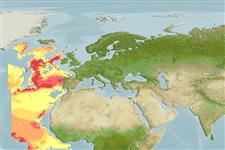>
Lophiiformes (Anglerfishes) >
Himantolophidae (Footballfishes)
Etymology: Himantolophus: Greek, himas or himantos = leather strap, thong or leash (referring to the thick leathery illicium) + Greek, lopho or lophio = crest or tuft (referring to the baited illicium projecting from the head) (Ref. 86949).
Environment: milieu / climate zone / depth range / distribution range
Ecología
marino batipelágico; rango de profundidad 400 - 750 m (Ref. 86949). Deep-water
Eastern Atlantic: Iceland (Ref. 12462) and off Madeira (Ref. 12965).
Tamaño / Peso / Age
Maturity: Lm ? range ? - ? cm
Max length : 21.5 cm SL (female)
Radios blandos dorsales (total): 5; Radios blandos anales: 4. Distinguishing characteristics of metamorphosed female: length of illicium 56-87% SL; bifurcated distal escal appendage some distance from base; each primary branch simple and darkly pigmented in small specimens, faintly pigmented in large specimens; length of primary branch 35-40% SL in specimens 3-3.8 cm, 78-83% in specimens 8.6-15.5 cm; unpigmented posterior escal appendage , length 3.5-13% SL; postolateral appendage on illicium 0-5, longest appendage 0-6.3%SL; escal bulb and appendages lacking dermal spinules (Ref. 86949).
Caught in bottom trawls and open pelagic nets in 400-750 m (Ref. 86949).
Life cycle and mating behavior
Madurez | Reproducción | Puesta | Huevos | Fecundidad | Larva
Jonsson, G., 1992. Islenskir fiskar. Fiolvi, Reykjavik, 568 pp. (Ref. 12462)
IUCN Red List Status (Ref. 130435)
Threat to humans
Harmless
Human uses
Más información
Nombres comunesSinónimosMetabolismoDespredadoresEcotoxicologíaReproducciónMadurezPuestaAgregación para la puestaFecundidadHuevosEgg development
ReferenciasAcuiculturaPerfil de acuiculturaRazasGenéticaElectrophoresesheritabilidadEnfermedadesProcesamientoNutrientsMass conversion
ColaboradoresImágenesStamps, Coins Misc.SonidosCiguateraVelocidadTipo de nataciónSuperficie branquialOtolitosCerebrosVisión
Herramientas
Special reports
Download XML
Fuentes de Internet
Estimates based on models
Phylogenetic diversity index (Ref.
82804): PD
50 = 0.5000 [Uniqueness, from 0.5 = low to 2.0 = high].
Bayesian length-weight: a=0.01995 (0.00906 - 0.04395), b=3.01 (2.83 - 3.19), in cm total length, based on all LWR estimates for this body shape (Ref.
93245).
Nivel trófico (Ref.
69278): 4.4 ±0.7 se; based on size and trophs of closest relatives
Fishing Vulnerability (Ref.
59153): Low vulnerability (16 of 100).
